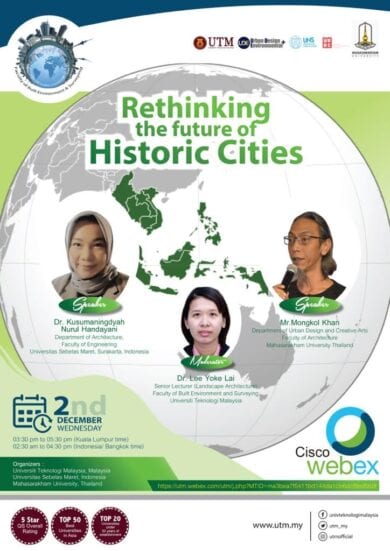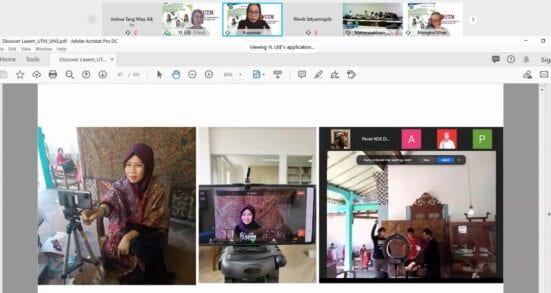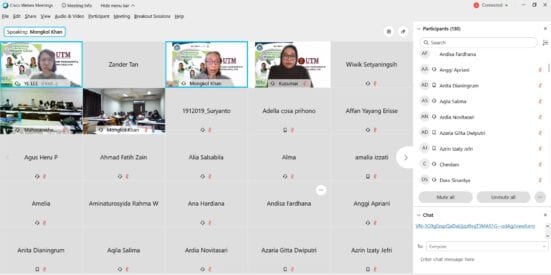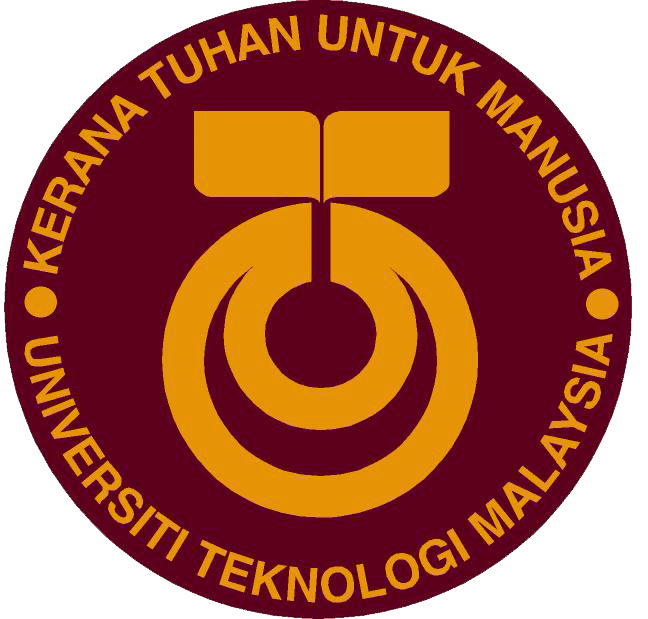The Urban Design and Environmental (UDE) Research Group, Faculty of Built Environment and Surveying, Universiti Teknologi Malaysia (UTM), hosted the Online Global Classroom (OGC) Webinar on 2nd December 2020. The webinar had involved collaboration with Universitas Sebelas Maret (UNS), Indonesia and Mahasarakham University (MSU), Thailand.
The main objective of the webinar was essential to discuss the current threat and conservation of historic cities in South East Asia regions. The webinar was executed within two hours, which started from 3:30 PM to 5:30 PM. The total number of attendees was 208 participants from UTM, UNS and MSU (84 UTM students; 71 UNS students; 45 MSU students; five UNS Academic staff; and three others).

The webinar began with a warm welcome from the two invited speakers. The first speaker, Dr. Kusumaningdyah Nurul Handayani (Architecture Department, UNS), shared a lecture on Discover Historic Urban Landscape of Pecinan Lasem, an inspiring case study of a historic city flourishing batik industry and the unique community of mixed culture of Chinese Indonesian.
Lasem or namely “the little China” (Tiongkok Kecil-Indonesia language) of central Java is safeguarding by the intangible heritage comprises Indonesia batik recognised by UNESCO, local narrative stories, culture, food, festival, as well as ceremonies. Moreover, the tangible heritage of Lasem historic city possessed significant architectural buildings such as a batik house, worship buildings, townhouses, and private residences which inherited the Javanese, Fujian China, Indische empire, Chinese Hindi, and colonial architectural styles.
Therefore, Dr. Kusumaningdyah highlighted that adopting the historic urban landscape is a vitality to preserve the cultural heritage identity of Lasem. Meanwhile, the transformation of adaptive reuse heritage buildings provides the benefits of regeneration of Lasem in sustaining the living heritage, livelihood, and heritage assets.

Mr. Mongkol Khan, a senior lecturer from the Department of Urban Design and Creative Arts, Mahasarakham University (MSU), shared a lecture on the collective case study of traditional streets in Hanoi, Vietnam; Jonker Street, Melaka; China Town, Bangkok; and Malioboro street, Indonesia. Traditional streets in South East Asia regions are essential places for people to conduct their way of life and cultural significance.
The formation of traditional streets was characterised by multicultural forms, traditional trading, formal-informal street activities, street vendors (mobile and fixed), informal setting and shared space. Hitherto, the traditional street spaces became a melting pot for both cultural and commercial significance for people to convey cultural practice, traditional custom, significant knowledge, and commercial activities.
Indeed, the evolutions of times have formed physical built forms, human aspects (activities), and cultural identity of the current traditional street. The influential and remaining of the tangible and intangible heritage of each traditional street had strengthened the liveliness of cultural space in a historic city.

Shortly after the sharing session of case studies by Dr. Kusumaningdyah and Mr. Mongkol Khan, there was a discussion and wrap up sessions to conclude at the end of this webinar. The challenge of “Rethinking the future of historic cities” was the most concern due to the impact of urban threats and the changing characteristics of historic cities. Also, the COVID-19 pandemic had caused the change of function and activities of historic cities. The diversity of the cultural-led activities in historic cities through heritage tourism, educational and awareness activities will accelerate and nourishing heritages in the economic, social and environment.
At the end of the discussion, the session pointed out important points of protecting and sustaining historic cities through community engagement, sharing knowledge on conservation approaches, urban heritage management, and policies enforcement. In short, this webinar has accomplished to achieve the faculty’s outbound mobility programme.




